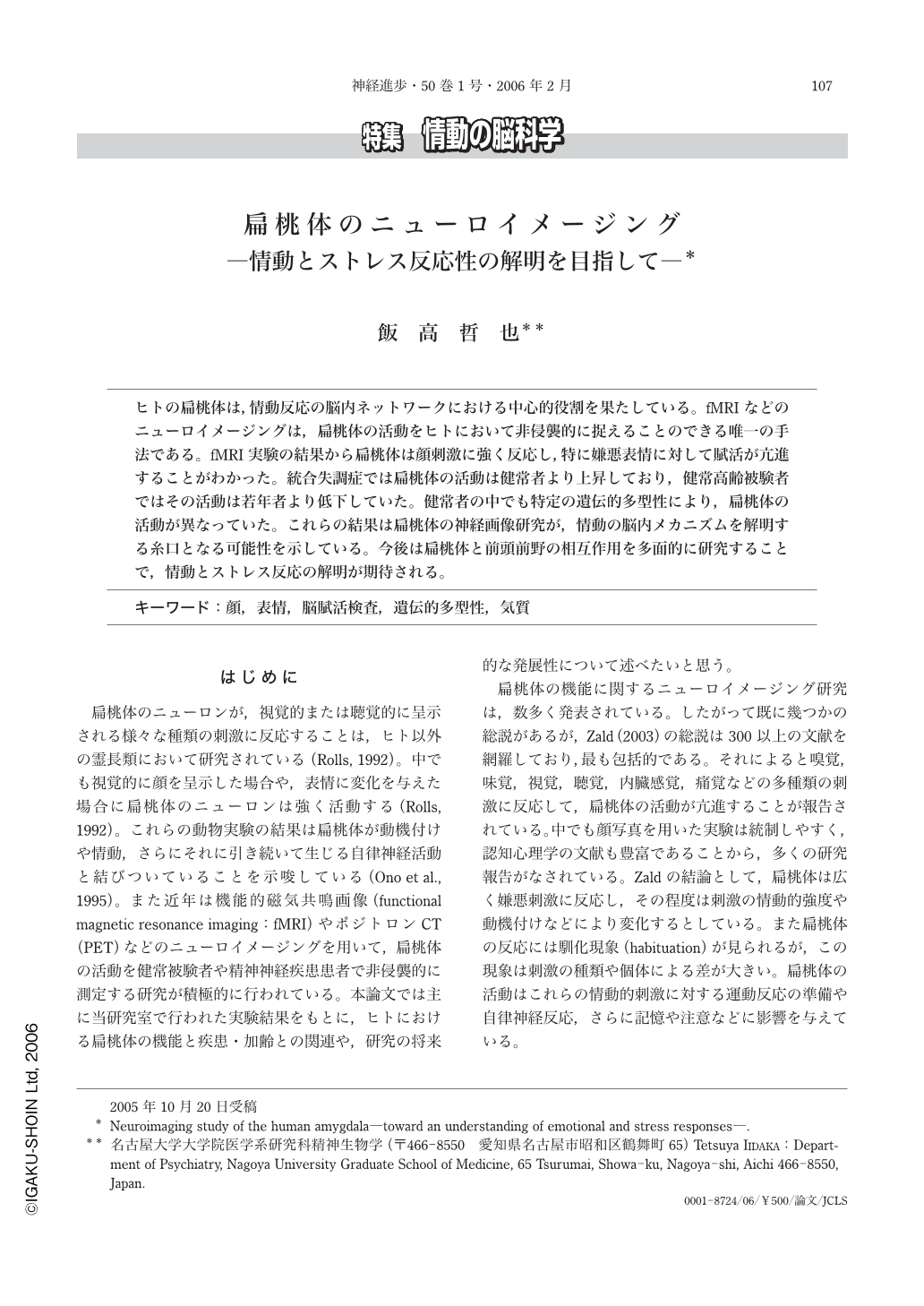Japanese
English
- 有料閲覧
- Abstract 文献概要
- 1ページ目 Look Inside
- 参考文献 Reference
ヒトの扁桃体は,情動反応の脳内ネットワークにおける中心的役割を果たしている。fMRIなどのニューロイメージングは,扁桃体の活動をヒトにおいて非侵襲的に捉えることのできる唯一の手法である。fMRI実験の結果から扁桃体は顔刺激に強く反応し,特に嫌悪表情に対して賦活が亢進することがわかった。統合失調症では扁桃体の活動は健常者より上昇しており,健常高齢被験者ではその活動は若年者より低下していた。健常者の中でも特定の遺伝的多型性により,扁桃体の活動が異なっていた。これらの結果は扁桃体の神経画像研究が,情動の脳内メカニズムを解明する糸口となる可能性を示している。今後は扁桃体と前頭前野の相互作用を多面的に研究することで,情動とストレス反応の解明が期待される。
The amygdala plays a critical role in the neural system that is involved in emotional responses and conditioned fear. Dysfunction of this system is thought to be a cause of several neuropsychiatric disorders(e. g., schizophrenia, depression, and anxiety disorder). A neuroimaging study using fMRI provides a unique opportunity for noninvasive investigation of the human amygdala with high spatial resolution. We have studied the activity of this structure in normal young subjects, normal old subjects, and patients with schizophrenia by using the face recognition task. Our results have shown that bilateral amygdalae were significantly activated by the presentation of face stimuli, as compared with that of other stimuli such as a house. This activation was modulated by the expression of the stimuli;that is, the negative face expression activated the amygdala to a greater extent as compared with a neutral face. In addition to the explicit presentation of face pictures, the amygdala also responded to the face that was shown only briefly for 35 ms. These observations indicate that the amygdala is extremely sensitive to face stimuli that has a biological value for primates, including humans. Activation of the amygdala was significantly lower in healthy old subjects than in young subjects, particularly when negative facial expression was presented. Schizophrenic patients showed enhanced activity in the right amygdala while performing an emotion discrimination task. In addition, single nucleotide polymorphism, C178T, in the regulatory region of the serotonin type 3 receptor gene(HTR3A)had significant modulation effects on the amygdaloid activity in normal subjects. Amygdaloid activation was greater in subjects with C/C alleles than in those with C/T alleles. The difference in the reaction time between the genotypes was also significant. In the C/C group, the right amygdaloid signal negatively correlated with the harm avoidance score. These results indicate that there is a substantial difference in the brain activity associated with the face recognition task, probably with regard to emotional learning among normal individuals. The variation in the neural responses that is partly explained by the genetic factors may be related to the variation in the susceptibility for socio-psychological stress. Thus, studies pertaining to the human amygdala would greatly contribute to elucidating the neural system that determines emotional and stress responses. A focus of the future study is to reveal the functional interaction of the amygdala and other parts of the brain such as the prefrontal cortex. In particular, the medial prefrontal cortex has rich connections with the limbic region and is involved in the extinction of fear conditioning. An impaired response with respect to fear extinction is a biological model of anxiety disorder and posttraumatic stress disorder. To clarify the functional relevance of limbic-prefrontal dysfunction and neuropsychiatric disorders, further studies using physiological, genetic, and hormonal approaches are essential.

Copyright © 2006, Igaku-Shoin Ltd. All rights reserved.


